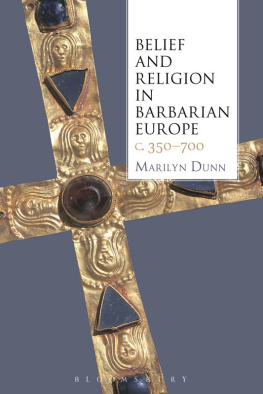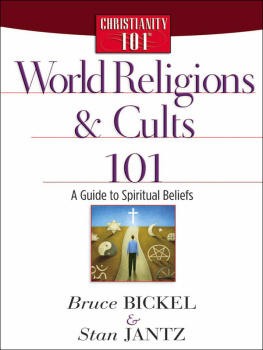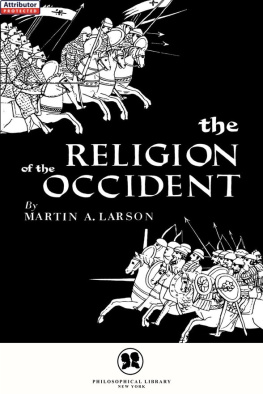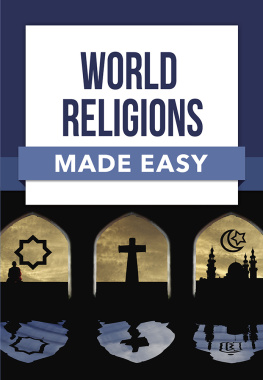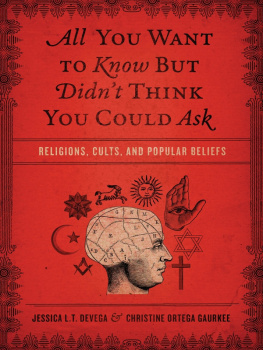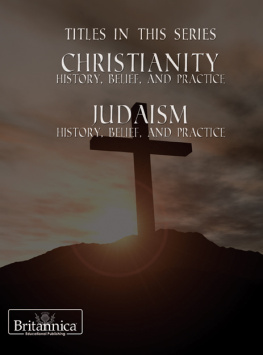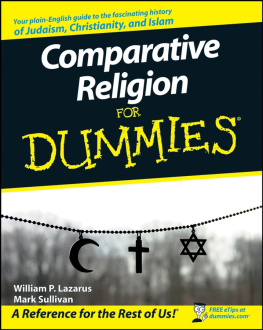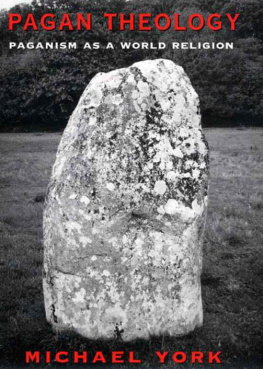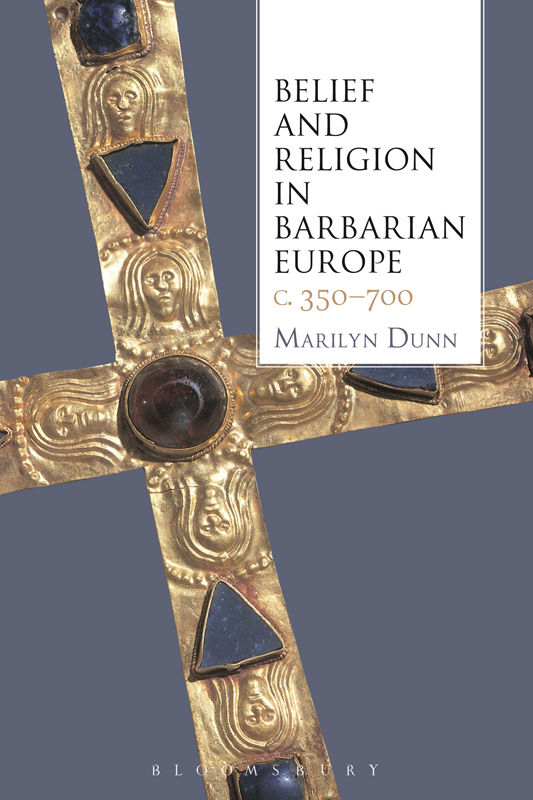Belief and Religion in Barbarian Europe c. 350700
Belief and Religion in Barbarian
Europe c. 350700
Marilyn Dunn
Contents
AASS Acta Sanctorum
AHR American Historical Review
Annales ESC Annales, conomies, Socits, Civilisations
GC Gregory of Tours, Glory of the Confessors
GM Gregory of Tours, Glory of the Martyrs
DLH Gregory of Tours, Decem Libri Historiarum ( History of the Franks )
HL Paul the Deacon, History of the Lombards
MGH Monumenta Germaniae Historica
VP Gregory of Tours, Life of the Fathers
ZKG Zeitschrift fr Kirchengeschichte
First of all, I would like to thank Ben Hayes, formerly of Continuum Publishing, who provided unfailing support when I was writing my previous book, The Christianization of the Anglo-Saxons and who commissioned this volume. I am also grateful to Claire Lipscomb and Michael Greenwood for their help in its early stages and to Ian Buck, Charlotte Loveridge and Dhara Patel for seeing it through to production.
I want to take this occasion to express my warmest thanks to Tony Goodman and Brenda Bolton for their encouragement and support throughout. I am also deeply grateful to Judith George, who read the whole manuscript and made sage suggestions for its improvement.
The work for this volume took place in the national libraries of France, Italy, Spain and Portugal and in regional libraries and museums in all these countries. Further research and writing was mainly carried out in two great libraries: Glasgow University Library and the National Library of Scotland. I am greatly indebted to the staff of both. In particular, I want to thank the DDS department of the former, whose labours extend the vast range of materials available in GUL even further; and most of all the Reading Room staff of the latter who have looked after me so very well over the years. Thanks too to Rachel Douglas and Nikki Macdonald for their supportive intellectual companionship at Table B of the NLS Reading Room.
I dedicate this book to Michael Baron, without whom it would not have been completed.
MD
From the late fourth century onwards, Germanic peoples entered the Roman Empire in large numbers. The first to do so were groups of Tervingi and Greuthungi, who were permitted to cross the Danube in 376, followed by further groups of Greuthungi in 386 and 405/6. All were fleeing Hunnic attack and hoped to find greater security inside the imperial frontiers. In the 450s, Gothic groups escaping Hunnic hegemony entered imperial territories: first the Balkans and then Italy. And in the late 560s, not long after the Gothic state created in Italy in the 490s had been destroyed by the armies of the East Roman Empire, the Lombards began to move into Italy.
This book is concerned with belief and religion among the barbarians who settled and created states in Western Europe: Tervingi and Greuthungi, who eventually became the Visigoths of southern Gaul and Spain; Sueves, Burgundians and Franks; the Balkan groups who became Italian Ostrogoths; and the Lombards. Who the barbarians were, where they originally came from and the manner in which they settled in Western Europe has been much discussed. If this is the case, it seems that the written sources afford only very limited indications of the way major population groups were formed (or dissolved) in this period.
In these debates over the issues of ethnogenesis, ethnicity, identity and state formation in barbarian Europe we can find some discussion of aspects of religious history of the barbarians and their conversion to Christianity; and religion is examined in a number of recent volumes devoted to the study of individual peoples.
This book offers something new. It focuses on the beliefs of continental Germanic peoples Goths, Sueves, Burgundes, Franks and Lombards in the period between c. 350 and c. 700, in which they settled in the territories or former territories of the Western Roman Empire and gradually accepted Catholic Christianity. It presents a study of belief based on the cognitive turn in the study of religion of recent years, expanding and developing the approaches pioneered in The Christianization of the Anglo-Saxons c. 597c. 700 .
The starting point for this study, in This enables a supra-cultural approach allowing us to compare, contextualize and extrapolate from limited information.
Another useful conceptual tool provided by the cognitive study of religion is the idea of abductive reasoning. Boyer coined this expression in the 1990s to explain the way in which people make surprising data unsurprising. It is a variety of post hoc , propter hoc reasoning used to explain the healing powers of natural features or the intervention of supernatural beings.
The cognitive study of religion also highlights the importance of intuitions of supernatural beings. This arises from what theorists regard as the human propensity to detect agency: that is, for individuals to seek reasons or forces behind events that affect them. Our mental architecture is geared up for the detection of agency in general. offers new ways of interpreting the diverse and scanty evidence for the supernatural beings venerated by the Germanic peoples.
also looks at the way in which the abandonment of the Homoian creed by the Empire in 381 effectively condemned Gothic Christianity to the margins and stifled its doctrinal development. Although it would prove a viable means of introducing other Germanic groups, such as the Sueves and Burgundians to Christianity, Homoianism would gradually become static and conservative, remaining an entry-level Christianity when barbarian rulers wanted to become full members of the Catholic club.
Building on this insight, this chapter offers a fresh view of the relationship between religion and politics as rulers opted, or attempted to opt, for Catholicism. It adds an extra dimension to current understandings of the tensions between kings and their warriors , suggesting that Arianism/Homoianism was favoured by the sections of the latter who felt threatened by the potential for a ruler to expand his power and prestige and fundamentally change his relationship with them if he succeeded in entering the Catholic macrocosm. It also suggests why Clovis, the ruler of the Franks, was able to make a direct transition from paganism to Catholicism. And a combination of the perspectives offered by Horton and by the cognitive study of religion sheds new light on the phenomenon of Lombard Arianism, as well as on Lombard rulers acceptance of Catholicism in the seventh century.
, looks at the ways in which the Church sought to achieve a Christianity that was more than superficial. It offers a way out of one of the most notable impasses in the study of early medieval religion: the question of whether we should accept or dismiss testimonies about the continuation of practices disapproved of by the Church long after Christianization. The question of their reliability has divided scholars, with some rejecting them altogether, others accepting them cautiously: acceptance or rejection has up to now been very much a matter of personal opinion. However, the cognitive study of religion indicates that rituals have common features across vastly different cultures, thus providing support for the idea that the apparent similarities between practices condemned over wide geographical areas and long periods are not simply a result of lazy ecclesiastics copying earlier writings.
A cognitive approach also enables us to move away from the misleading idea of pagan survivals amongst the Catholic Franks and Sueves. A survey of legislation indicates that after the Franks officially accepted Catholicism, practices involving major non-Christian deities seem to have died out relatively quickly (except perhaps on the north-eastern borders). The practices condemned by the Church are based on the continued intuition of certain natural features as being special. They involve what Justin Barrett has called nonreflective belief, belief that is not necessarily conscious or explicit, is This opens up new ways of looking at behaviours which the Church sought to discourage or encourage. The sermons of Csarius of Arles, works such as Martin of Bragas On the Castigation of Rustics and Gregory of Tours treatises Glory of the Martyrs and Glory of the Confessors appear in this light as part of the Churchs attempts to divert people from non-Christian nonreflective belief and replace it with attractive Christian alternatives, in the hope of strengthening their attachment to Christianity.

